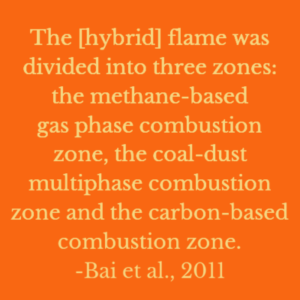1-Sentence-Summary: Comparison between hybrid and gas-only explosion in a 10-m3 chamber demonstrates different flame structures and increased flame thickness.
Authors: C. Bai, G. Gong, Q. Liu, Y. Chen, and G. Niu
Read in: Three Minutes
Favourite quote from the paper:

These authors perform experimental testing of methane gas explosion and hybrid methane gas/coal dust explosion in a 10-m3 chamber. The mixtures are ignited with a 40 J spark at the center of the cylindrical chamber. The coal dust has a particle size range between 45 and 75 µm.
Tests are completed for methane alone at concentrations ranging from 5 to 12 % by volume. Hybrid explosions are analyzed for methane and coal dust concentrations of 8% and 25 g/m3, 6.5% and 43.75 g/m3, 5% and 62.5 g/m3, and 4.5% and 68.75 g/m3
The authors present pressure time plots, maximum overpressure at specific locations, and flame speed data. High speed photographs are also used to determine the flame structure and flame thickness.
Three of the main findings from this paper are:
- The explosion progresses in two stages: a pressure accumulation stage and a pressure attenuation stage.
- Hybrid mixtures have a different flame structure than the gas alone.
- Flame thickness is much larger for the hybrid explosion.
The following sections outline the main findings in more detail. The interested reader is encouraged to view the complete article at the link provided below.
Finding #1: A two stage explosion occurs in the cylindrical 10-m3 chamber
The authors demonstrate a two stage combustion process in the explosion chamber. In the first stage, pressure rises as the flame propagates outward from the center of the chamber. In this stage the heat released by reaction is larger than the heat loss to the vessel walls.
Once the flame reaches the inner vessel walls, a second combustion stage occurs. Here heat loss is larger than heat generated from the remainder of the fuel reacting. In this stage the pressure decreases until the end of the explosion.
Finding #2: Hybrid mixtures demonstrate a three stage explosion structure
From high speed photographs a two stage structure is seen for pure methane flames. A thin blue flame propagates spherically through the chamber, followed by a yellow flame at the center that attenuates over time. The blue flame is the methane reaction front and the yellow flame is the combustion productions from the initial ignition.
High speed photographs from the hybrid mixtures demonstrate a three stage structure. A thin red flame propagates from the center, followed by a yellow flame, and bright white section at the center of the chamber. In this case the inner flames did not attenuate with time.
The authors propose that the three stage structure of the explosion flame is from different combustion steps in the hybrid reaction. The outer red flame is the methane gas combustion, the second yellow zone is combustion of the coal volatiles, and the inner white zone is combustion of the remaining char in the coal.
Finding #3: Hybrid flame thickness is an order of magnitude larger than gas flames
The methane flame thickness is measured from the high speed photographs. For 8% methane the thickness is around 1 mm and stays constant during the explosion. Alternatively, the hybrid flame thickness increases during the explosion. The outer red flame and inner yellow flames both started around 2.5 mm, but increase to 35 mm and 10 mm, respectively, by 30 ms.
My Personal Take-Aways From
“The Explosion Overpressure Field and Flame Propagation of Methane/Air and Methane/Coal Dust/Air Mixtures”
This paper presents some interesting results for gas and hybrid explosion in large chambers. Although measurements from high-speed photographs is often difficult, the results qualitatively demonstrate differences in flame structure and thickness for gas and hybrid mixtures.
This paper is useful to industry as the vessel size and geometry is realistic for processing applications. It would be interesting to see how the hybrid flame structure changes findings in simplified models of flame propagation in cylnidrical chambers, such as developed by Singh, 1988 for gas explosion.
Full Citation: [bibtex file=references.bib key=Bai2011]
[otw_shortcode_button href=”http://www.sciencedirect.com/science/article/pii/S0925753511001160″ size=”medium” icon_position=”left” shape=”square”]> > Get The Article[/otw_shortcode_button]
